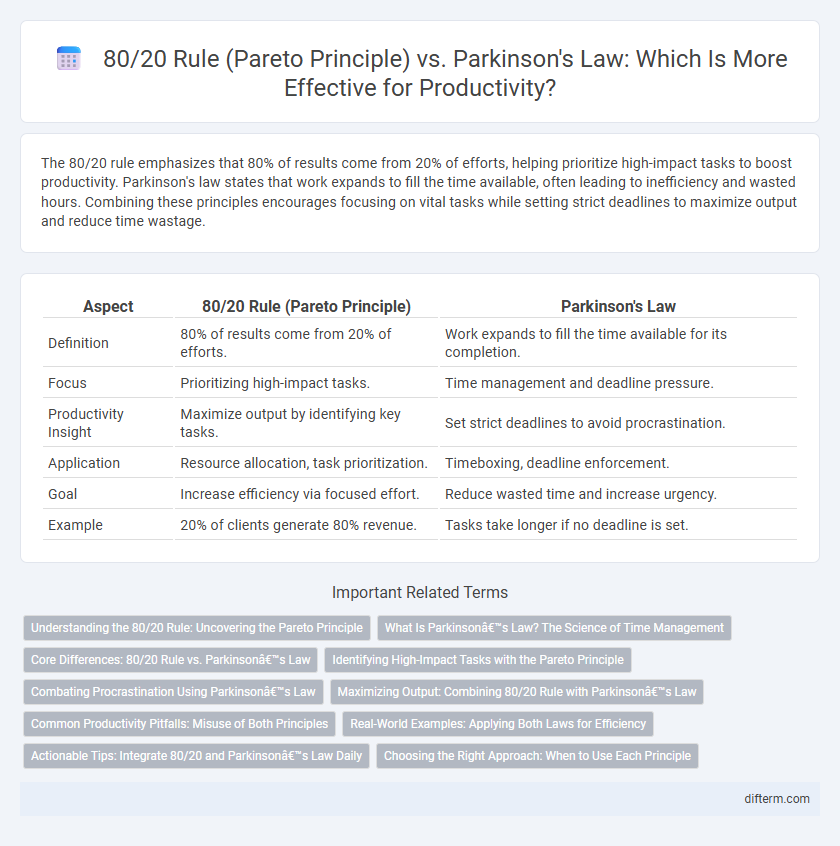The 80/20 rule emphasizes that 80% of results come from 20% of efforts, helping prioritize high-impact tasks to boost productivity. Parkinson's law states that work expands to fill the time available, often leading to inefficiency and wasted hours. Combining these principles encourages focusing on vital tasks while setting strict deadlines to maximize output and reduce time wastage.
Table of Comparison
| Aspect | 80/20 Rule (Pareto Principle) | Parkinson's Law |
|---|---|---|
| Definition | 80% of results come from 20% of efforts. | Work expands to fill the time available for its completion. |
| Focus | Prioritizing high-impact tasks. | Time management and deadline pressure. |
| Productivity Insight | Maximize output by identifying key tasks. | Set strict deadlines to avoid procrastination. |
| Application | Resource allocation, task prioritization. | Timeboxing, deadline enforcement. |
| Goal | Increase efficiency via focused effort. | Reduce wasted time and increase urgency. |
| Example | 20% of clients generate 80% revenue. | Tasks take longer if no deadline is set. |
Understanding the 80/20 Rule: Uncovering the Pareto Principle
The 80/20 Rule, or Pareto Principle, reveals that roughly 80% of results stem from 20% of efforts, emphasizing the importance of identifying and focusing on high-impact tasks for maximum productivity. In contrast, Parkinson's Law highlights how work expands to fill the time allotted, underscoring the need to set strict deadlines to prevent inefficiency. Mastering the balance between these principles enhances time management by concentrating efforts on critical tasks while avoiding unnecessary time extensions.
What Is Parkinson’s Law? The Science of Time Management
Parkinson's Law states that work expands to fill the time available for its completion, highlighting the tendency to procrastinate when deadlines are loose. The 80/20 rule (Pareto principle) emphasizes that 80% of results come from 20% of efforts, encouraging prioritization of high-impact tasks for maximum productivity. Understanding Parkinson's Law promotes setting strict deadlines and time limits to enhance focus and efficiency, counteracting inefficiencies caused by unnecessary time extension.
Core Differences: 80/20 Rule vs. Parkinson’s Law
The 80/20 Rule, or Pareto Principle, emphasizes that 80% of results stem from 20% of efforts, highlighting the importance of prioritizing high-impact tasks to boost productivity efficiently. Parkinson's Law states that work expands to fill the time available, suggesting that deadlines influence the duration and focus of task completion. While the 80/20 Rule centers on task prioritization for maximal output, Parkinson's Law addresses time management and how imposed constraints affect productivity.
Identifying High-Impact Tasks with the Pareto Principle
The Pareto Principle highlights that 80% of results often come from 20% of tasks, emphasizing the importance of identifying high-impact activities to maximize productivity. Parkinson's Law states that work expands to fill the time available, which can dilute focus and efficiency if not managed. Prioritizing tasks using the 80/20 rule ensures concentration on critical activities that generate the most significant outcomes, overcoming the time-wasting pitfalls described by Parkinson's Law.
Combating Procrastination Using Parkinson’s Law
Parkinson's Law states that work expands to fill the time available, making it a powerful tool for combating procrastination by setting shorter, fixed deadlines to enhance focus and efficiency. The 80/20 rule (Pareto principle) identifies the critical 20% of tasks that generate 80% of results, while Parkinson's Law directly addresses time management by preventing tasks from dragging on unnecessarily. Leveraging Parkinson's Law helps break procrastination cycles by creating urgency, forcing prioritization, and reducing wasted time on low-value activities.
Maximizing Output: Combining 80/20 Rule with Parkinson’s Law
Maximizing output requires leveraging the 80/20 rule by identifying the critical 20% of tasks that generate 80% of results, while Parkinson's Law enforces strict time limits to prevent work from expanding unnecessarily. Combining these principles enhances productivity by prioritizing high-impact activities and imposing deadlines that drive efficient task completion. This strategic integration optimizes resource allocation and accelerates goal achievement within constrained timeframes.
Common Productivity Pitfalls: Misuse of Both Principles
The 80/20 rule (Pareto principle) emphasizes that 20% of efforts yield 80% of results, but misapplying it can lead to neglecting essential tasks outside the critical 20%. Parkinson's law states that work expands to fill the time available, yet overestimating deadlines can cause procrastination and inefficiency. Misuse of both principles often results in skewed prioritization and wasted time, undermining overall productivity.
Real-World Examples: Applying Both Laws for Efficiency
The 80/20 rule reveals that 80% of results come from 20% of efforts, guiding professionals to prioritize high-impact tasks like sales that generate most revenue. Parkinson's law shows that work expands to fill the time available, so setting tighter deadlines for projects such as software development sprints increases focus and reduces wasted hours. Combining these laws enhances productivity by identifying key activities while imposing time constraints, exemplified by marketing teams maximizing campaign results within strict timelines.
Actionable Tips: Integrate 80/20 and Parkinson’s Law Daily
The 80/20 rule highlights that 80% of results come from 20% of efforts, emphasizing prioritizing high-impact tasks for maximum productivity. Parkinson's Law warns that work expands to fill the time available, encouraging setting tight deadlines to maintain focus and efficiency. Combining these principles daily by identifying key tasks and imposing strict time limits drives more effective time management and actionable outcomes.
Choosing the Right Approach: When to Use Each Principle
The 80/20 rule (Pareto Principle) is ideal for identifying the vital few tasks that yield the majority of results, enhancing productivity by focusing efforts on high-impact activities. Parkinson's Law highlights how work expands to fill available time, making it effective for setting strict deadlines to prevent inefficiency and procrastination. Choosing the right approach depends on whether the goal is to prioritize key tasks or to optimize time management and limit task duration.
80/20 rule (Pareto principle) vs Parkinson’s law Infographic

 difterm.com
difterm.com